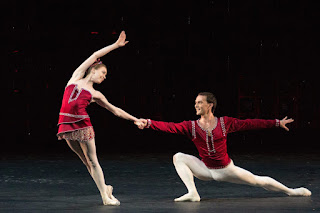Ballet: A glittering multinational collaboration for Balanchine’s Jewels
Sunday I saw one of those hot ticket only-in-New York things, a joint
performance of the Paris Opera Ballet, the Moscow Bolshoi, and the New York
City Ballet, each performing one act of George Balanchine’s (1904-1983)
abstract ballet Jewels, created for
the NYCB in 1967. This extravagant collaboration made sense, since each of Jewels’ three acts portrays a balletic
style formative both to Balanchine’s career and to ballet generally: French
(Emeralds), Rubies (American), and Diamonds (Russian). The ballet is not about jewels, but jewels bedeck the
dancers throughout and inform the set décor. There is no plot, and the three
parts are often performed separately. Jewels
is historically notable for being the first full length (90 minute) plotless
ballet.
The opening "Emeralds", done here by the Parisians, is a calm,
flowing warm up. The dance has a few spins, but no leaping, and matches flowing
arms, long tuile gowns and smooth lines to calm, hyper-romantic music of Fauré.
Having not seen it before, it seemed in this performance to lack the rhythmic
definition that Balanchine usually asks of dancers, feeling more like an
undefined, airy serenade. But, in a way, that was perhaps exactly the point of
this movement, and the French danseurs’ suppleness and relaxation made the
episode feel like a relaxed day in a warm green glade. A recurring motif was a
slinky, supple movement in reverse direction used by dancers to exit the stage.
Each troupe brought its own costumes (the originals from 1967 by Karinska are
still used by NYCB). This was a little odd in Emeralds, as the bluish-green
tint of the new Parisian costumes by designer Lacroix clashed a bit with the NYCB
emerald backdrops.
The second movement "Rubies" is a jazzy, American-inspired work that
exhibits the modernistic developments of Balanchine’s American career. The dancing requires ultimate flexibility, rhythmic sensitivity, and agility (see this excerpt from NYCB 1979 with the wonderful Mikhail Baryshnikov and Heather Watts). In Rubies a
recurring motif is steps and leaps not on pointe, but instead with feet held
at a right angle to the legs, often balancing on heels. The edgy, animated, upbeat
style perfectly reflected the score, Stravinsky’s Capriccio for Piano and Orchestra. It would seem that this might
have best fit the style of the NYCB, but in this performance they switched off
with the Bolshoi on alternating nights for Rubies and Diamonds, and I saw the Bolshoi
dancers. The dancers were, in the Russian style, tall, athletic, and
extraordinary in their use of long extensions and expressive arms—you can also
see this in the best Russian ice skaters. They seem to take a more virtuosic
approach than do the Americans, and in a solo seem to dominate the stage. This
may not have been ideal for Rubies however, which is more of a snappy tongue in
cheek ensemble piece. Also, the exacting steps and Stravinsky’s rhythms warrant
exact precision, and their steps sometimes seemed to fall just after the beat,
rather than precisely with it. I would like to see NYCB do this movement for
comparison. Their costumes (left, below) more strongly evoked the jazz origins
of the dance than do the originals (right): the women are now dressed as
flappers. I liked this but wondered if such a conscious era-specific depiction
was in line with the abstraction that Balanchine favored.

The final piece "Diamonds" is a neoclassical evocation of the grand Russian style. Ballerinas are now in tutus, dominated by one prima ballerina. We see traditional ensembles and pas de deux, all set to the last 4 movements of the Tchaikovsky Third Symphony (all very danceable--two waltzes, a scherzo and a polonaise). Balanchine’s take on classical ballet is always interesting, as he allows the stars to dominate while making the ensembles a bit more interesting and complex that what is normally seen in 19th century classical ballet. An example of this occurs when the last movement of the symphony becomes fugal…not a thing normally set to ballet, but here well suited to Balanchine’s neoclassical way of moving the corps around. (In this wonderful linked excerpt by the Mariinsky Ballet, please bear with the inserted 15 second commercial, and watch through to the regal ending, capped by a classic Balanchine V-shaped ensemble.) While "Diamonds" feels like we are amidst the grand ballets of Tchaikovsky’s time, it’s all been updated and clarified, so the dance now truly mirrors the music in a more twentieth century way. This is the genius of Balanchine.
The NYCB performed Diamonds in the performance I saw, and one quickly sees that they lack the tall, thrilling uniformity of the Bolshoi corps. There is a more American variability and individualism in the corps and solo dancers, and the excellent lead ballerina Sara Mearns exhibited less Russian regal domination than intense involved expression. Mearns was performance was less about her than about Tchaikovsky and Balanchine. Perhaps this is a matter of taste, but I missed the regal Russian classical style here. There is a certain splendor in seeing mass movements of near-identical dancers: both Busby Berkeley in the film musicals of the 1930’s dancing chorines) and Leni Riefenstahl in Triumph of the Will (marching Nazis) knew this well, and how such perfection can create a thrill in the viewer. In the end, the best match for Jewels may was probably the regal Bolshoi in Diamonds, with the NYCB in the jazzy Rubies. But it was fascinating to see the differing company styles side by side, all in the service of the greatest twentieth century choreographer. Balanchine is unique among choreographers I have encountered in making his chosen music better than when just hearing it alone---here marked by the "minor" Stravinsky and Tchaikovsky pieces, each of which came to brilliant, rhythmic life with the accompanying choreography. Genius indeed.


Comments
Post a Comment